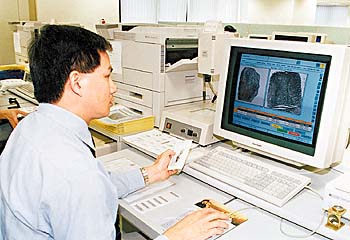As time goes by - a print is just a print, and more
 Still in print: Computers now allow the storage of more prints for longer, while also providing ultra-fast matches and access |
A fingerprint can be as distinctive as a person's face, speedily leading to a positive identification and arrest. However, seeking out those elusive distinctions had always been the hard part of fingerprint identification. Not any more.
The inroads in fingerprint gathering from crime scenes and the storing of fingerprint files has seen a massive overhaul in the past decade.
Fingerprints have been used by the Force for criminal identification since the turn of the century. From the simple powder and brush technique of old, technological revolutions such as lasers and assorted chemical treatments and solutions have now made fingerprints liftable from some of the most notoriously difficult surfaces which detectives never previously stood a chance of finding a clue.
Computers have also taken over much of the time-consuming legwork of storing and finding files, and in particular, the actual scouring of print photos for the tell-tale characteristics which make fingerprints as distinguishable as a face.
The installation of the Identification Bureau's advanced computer setup increased immensely the speed in which a detective can have his request for fingerprint detection, analysis and matches, delivered.
Bureau Chief Inspector Shaun Dove said the innovations have allowed for arrests within hours of a crime.
"Such speed has proven to be an incredibly valuable asset in many cases, particularly in a kidnapping not long ago where the child victims were located within about 24 hours. The culprit had held them for ransom and we were given two betting tickets from which we managed to detect prints using chemicals within the hour. Matches were found by the computer within two hours and a positive identification was made within six. This allowed detectives to quickly locate him and save the kids.
"In the old days working manually to such a restricted number of subjects, this guy may have got away. Before 1986, we only positively identified about 600 people a year. When we started using chemicals on surfaces the number of identifications jumped to 800-plus per year. But since the computer database was installed this has more than doubled to around 2,000 identifications a year.
"It is fantastic the speed we are doing things at now. Officers before may have had to wait up to two months for these services. But now, maximum, within a week. We have quite a lot of identifications made within 24 hours." And CIP Dove is quick to point out that not just technological advances but also chemical ones have also led to increased precision and speed in print detection.
About one third of all identifications last year were made through the Bureau's Advanced Technology Section (ATS) which uses chemical solutions, dyes, lasers and ultra-violet lights and even superglue and fumigation ovens to highlight prints on a wealth of difficult surfaces impossible to work with previously, such as wood and plastics with fine texture.
The processes can expose prints left during a crime even after lengthy periods of time, particularly on paper.
Processing a crime scene using powders remains the most practised and effective way of detecting fingerprints on smooth, non-porous surfaces. However, the introduction of chemical and other scientific techniques to process other types of surfaces has been a fantastic success with an identification rate consistently high, up to 33 per cent.
"This has been one of the major achievements of IB," he said.
The Section has proved so vital, renovations to its 11th-floor laboratory in Arsenal House West Wing have increased its capacity further with the ever-expanding demand for print identification.
Meanwhile, the computer database stores more than 730,000 fingerprint files and spares officers the burden of having to manually sift through them via the old wooden cabinets which have been used since before World War Two.
<< Back to Index >>